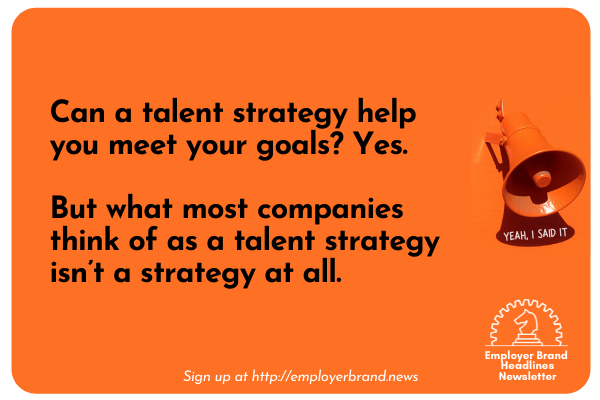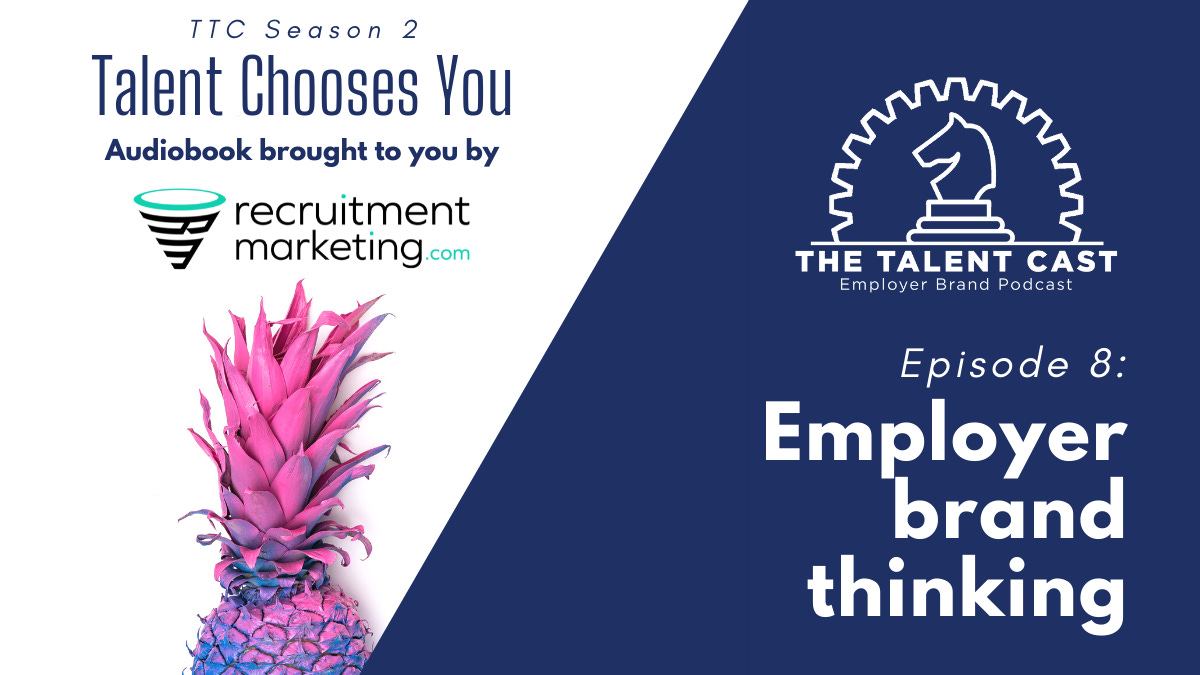🍍 Employer Brand Headlines: The "The Working Hour" Edition (#136, resend)
Is your talent strategy a talent strategy?
NOTE: it seems like this email didn’t get sent, so I’m re-sending.
I’m very sorry if you’re getting this twice. -James
Our mission: push the conversation around employer brand forward.
Employer Brand Headlines, is brought to you by James Ellis.
In this issue…
Do you even have a talent strategy?
Comedy for job postings?
How to hire women
The tone knob
The big idea
How did Apple become Apple? By being excellent strategists. There was a time when they survived the PC/Microsoft onslaught by choosing not to be everyone’s computer, but the computer of your creative friend. It was a strategy of not fighting a fight they could'n’t win, and so chose to optimize and maximize around a smaller niche audience with high margins.
Years later, when Steve Jobs came back, Apple suffered from a confusing litany of products, product options, customizations and different retailers competing to sell someone the same Apple product. Their strategy was to streamline the product listing from hundreds of SKUs to a dozen, and pull back on almost every retailing partnerships. The strategy centered on things simple, to streamline inventory and production internally, but by offering the world three kinds of computers, one in five colors.
Why bring these things up? To illustrate what strategy is: the means by which you achieve a goal (in 1995, to survive and thrive in a world that was Windows-crazy, and in 1998 to have a clearer reason to buy).
In both cases, there was a clear goal for the strategy to achieve. But there was also a choice in what manner the goal would be achieved. In 1995, they didn’t try to be both the computer for creatives AND the computer for people at work (i.e. being the computer for everyone) because that would get them trounced by MS. In 1998, they didn’t try to streamline SKUs and offer twenty new products, because those strategies would cancel each other out. Both strategies were choices that had opportunity costs. (Godfather of business strategy Michael Porter says strategy is as much what you choose not to do as it is what you do.) Apple were leaving money/market share on the table (marking a sacrifice) in order to focus their efforts on what mattered.
Finally, not only did these choices achieve a goal and force a decision, they were strategies only they could use. MS couldn’t have woo-ed creatives, as they didn’t have Photoshop (they offered MSPaint for years)! And MS didn’t even have hardware to sell, only an operating system (and later MS Office), so they couldn’t have scaled back SKUs.
A good strategy has three core elements: A goal, a choice, and a unique position.
This kind of thinking runs counter to almost anything I’ve seen calling itself “talent strategy.”
If you ask any company what their talent strategy is, you’ll hear a lot of very similar answers:
Be an attractive employer
Outreach/source/recruit like crazy
Look within (focus on entry-ish level folks and promote from within, or leveraging referrals)
Offer more money than the other company
Pay an outside agency to bring in talent
But in most companies, the “talent strategy” isn’t one of these, it’s ALL of these.
And while all these things can help get a company achieve a goal (maybe), choosing all strategies ISN’T a choice. And if every company is able to try and leverage all five ideas, it can hardly be called unique.
Mis-labeling tactics and calling it a “strategy” is pretty common in business. In fact, there’s a litmus test to see if what you think is a strategy can even be called that. Take your strategy and reverse it. If it makes sense when you reverse it (whether or not you’d chose that option), its fair to call it a strategy.
But if you reverse all the five talent strategies, you’re left with… nothing. Make your company less attractive? Not recruit? Don’t promote? Offering less money as a strategy? Not hiring agencies?
Clearly, these aren’t strategies. They are tactics. And beyond being mis-labeled, thinking of these things as strategies means we don’t do the hard work to think of good talent strategies.
What qualifies as a valid talent strategy?
Focus all efforts in one location (geo, industry micro-sector, title) instead of spreading messagings anywhere
Make it harder for people to apply or engineer a completely new application process designed to encourage only strong candidates in
Offer (and lean on) a global referral bonus so that if anyone (in or out of the company) refers a hire, they get a bonus (turning the world into your sourcer)
Each one of these is a means to achieve a goal (hiring great talent), a choice (focusing on a select audience, means, or channel), and involves something other companies would be hard-pressed to do.
Can a talent strategy help you meet your goals? Yes. But what we think of as a talent strategy isn’t a strategy at all.
Yep, we’re still podcasting about a book.
The revised and annotated audio version of Talent Chooses You (the revenge!) continues with episode 8 about how “thinking in employer brand” can help you change your recruiting and talent acquisition world.
Headlines!
Redefining Your Purpose in the Wake of the Pandemic
This is two-sided: how to think about your purpose, but also how others think about their own purpose. [HBR]
Teaming is hard because you’re probably not really on a team
Homemade Drake meme:
Talking about how well you collaborate : 😕
Showing how you build collaboration : 😏
[strategy+business]
Women in STEM: How to attract and retain the really-hard-to-hire
Data from Universum shows that as much as you say you want to bring women into your tech company, they might now want to go. (And other potentially useful facts about women in STEM.) [Universum]
Andrew Gadomski brings the data
Speaking of women, for all those of you saying how impossible it is to hire more women, Mr Gadomski would like a word. [LinkedIn]
When writing a job ad, pretend you’re a stand up comedian.
Go follow Mitch Sullivan on LinkedIn. No. That’s the post. Just do it. [via LinkedIn]
Marketers Guide To Gaining Board Member Buy-In
It is exactly what it says on the label [Business Strategy Insider]
Tech’s 'Hiring Crisis': It's Time to Rethink Way More Than WFH
If you think we’re the only ones talking about the great resignation (I’m not capitalizing it anymore. I’m just not. Put your AP stylebook down and get on with your life, people!), you’re wrong. [Linkedin]
Tone Knob
Some of you think I’m being a bit cheeky, but Tone Knob is my current favorite newsletter devoted exclusively to brand tone of voice using (mostly British) examples to offer lessons on how to think about (and build a much better) tone of voice for your brand [Substack]
What is Content Governance?
If more than one person at your company is making content for your brand, this is a must read (also, this is how you can solidify your position within the larger brand/content conversation [HubSpot]
Three unusual questions to make job candidates think
There’s probably some value in thinking about the questions your hiring managers ask in interviews to uncover how well the candidate aligns to culture and values (because asking “how well do you align to our values?” is a total bs question). [strategy+business]
Inside the fortune cookie
“The only thing harder than changing is paying the price for not changing.” - Shane Parrish
Thanks, everyone!
Search the 1,300 links in the newsletter archive.
Read Talent Chooses You for free from this open source Google Doc
Like the music? Here’s the song archive on Spotify.
If you have a question, just reply to this email and it comes directly to me.
Cheers and thanks!
-James Ellis (LinkedIn | Twitter | Podcast | Articles)
Where the subject line came from:
Tears for Fears - The Working Hour
This has to be one of the best produced albums of the 80’s (or at least most obsessively polished: it practically shimmers with little layers of sound here and there to create it’s own world). And while everyone loves Shout and Everyone Wants to Rule the World (shout out to its use use in Real Genius, Val Kilmer’s masterpiece), this track sits smack dab in between the two tracks. Part palate cleanser from Shout’s bombast, part tonal shift, it is cinematic and atmospheric, shifting from movement to movement, culminating in what sounds like a double-sax solo. I mean… c’mon…
If you are enjoying the music, I made a Spotify playlist of all the subject line songs I’ve used over the last year and a half:








